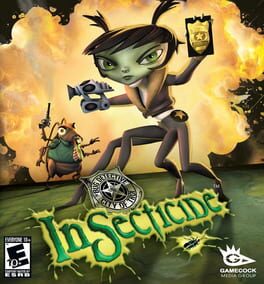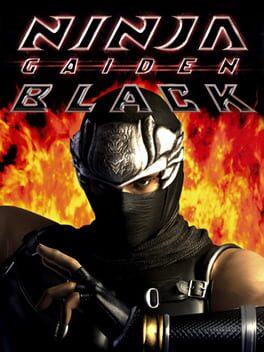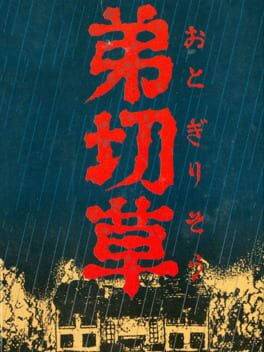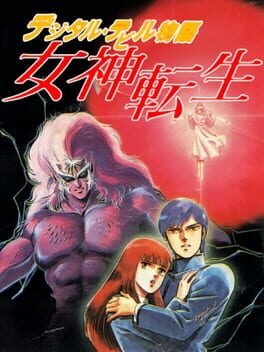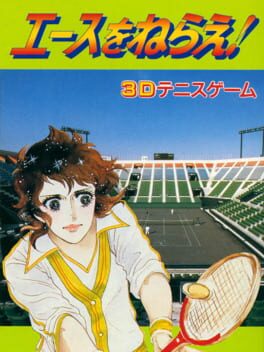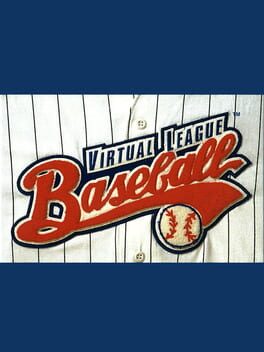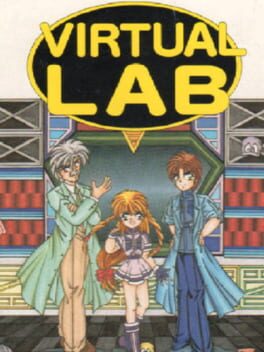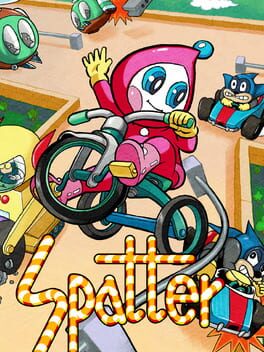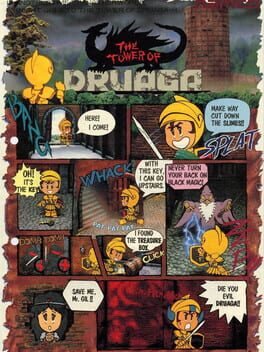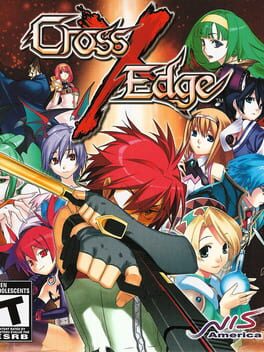oldinamerica
BACKER
185 Reviews liked by oldinamerica
Insecticide
2008
Ninja Gaiden Black
2005
What we have here is an incredible action game with a high skill ceiling. Would be a shame if someone added worms to it...
First things first: Ninja Gaiden Black looks incredible running on a Series X. There is a level of clarity and sharpness here that you just won't see in most other backwards compatible Xbox games - not unless it's also developed by Team Ninja - and even some 360 games upscaled to 4k don't look nearly as good. You can see every pixel on Rachel, and I know because I've spent hours in the lab analyzing her model. I have access to high-end Digital Foundry tools, and you will not believe the frame graph I've generated for Ryu's crotch-- this technology was NOT intended for these purposes!
Now this is where I out myself as a hack, because I did not beat this game on Ultra Lord-God Ninja mode or whatever the hell Ninja Gaiden Black's most powerful warriors insist is the one true way to enjoy the game. I'm a Centrist Ninja, I think any way you enjoy a game is the best way to enjoy it, even if you're a dog. A ninja dog, as some might be.
Even though I lack the requisite amount of skill to play Black on its highest difficulty, I'm more than capable of seeing what the game is going for and respect how technical it is. Look up any boss tutorial and you'll get a sense for how layered and complex Ninja Gaiden's combat can be. It's worth noting that none of the strategies therein actually helped me overcome some of Black's nastiest bosses when applied directly, but they did give me insight into the game's underlying mechanics which allowed me to develop tactics that worked for me. Brute force is seldom the answer, and Black rewards experimentation and thoughtful play, which is appreciable on any level of difficulty.
Unfortunately, I don't think I can jump onboard with the sentiment that this is the best action game ever. The rote reuse of certain bosses on normal difficulties and below can get tiresome, and though you can mitigate this by playing at higher levels, the trade comes at the cost of adding more mobs to boss battles. The few tastes I had of this during my playthrough didn't leave a positive impression, as the increased number of enemies didn't pay nice with the camera. An egregious case of this comes early with the second boss fight, where you have to manage an enemy on horseback running between the two edges of the arena while contending with wizards sniping at you and vanishing.
As the game crept on and abandoned interesting traversal for intense combat challenges in its last two levels, I found my investment waning. In a way, this is true to Ninja Gaiden's NES lineage, because like those games I found myself nearing the end and thinking "yeah I've had enough, I'm good." I understand clawing your way through several small rooms of meaty and tenacious enemies and rolling right into a boss rush is meant to be a true test of your skills, but I personally didn't find the attrition nearly as enjoyable as others. This shouldn't be taken as a full-throated dismissal of the game's combat, which I do like overall, but I did find myself waxing between disengagement and frustration towards the end.
Maybe some of my issues stem from a real bad case of Resident Evil brain for which I'm entering the terminal stages, because I found the parts of Black where you're roaming around and solving puzzles to be the most enjoyable. Yeah, I know, I'm a freak for thinking the combat is secondary to platforming and picking up weird totems to trek back to locked doors a level-and-a-half away. I have to live with myself every day of my life.
It's easy to get lost in the minutia of Ninja Gaiden Black's combat and difficulties, and if you really want to trip headfirst down the rabbit hole, you should check out all the subtle and big differences in Ninja Gaiden's many releases. I actually own a copy of 2004's Ninja Gaiden, which I mistakenly bought thinking it was a totally different game. It was only when I was a breath away from grabbing Sigma under the same assumption that I realized what I'd done, so I just have a spare lying around if anyone wants it. Just post your full address in the comments (DO NOT DO THIS, I WILL DELETE YOUR COMMENT AND SEND YOU A COPY OF AMERICA'S AMY INSTEAD AND IT WILL BE ON YOU FOR TRUSTING ME.)
Some problems inherent to the game and more still that amount to personal taste keep Ninja Gaiden Black from leaving the same impression on me that it does others, but I certainly see why people feel so passionately about it. I eagerly await them telling me how I played the game wrong and am a bastard for it, which is always the best way to get people to enjoy things the same way you do.
First things first: Ninja Gaiden Black looks incredible running on a Series X. There is a level of clarity and sharpness here that you just won't see in most other backwards compatible Xbox games - not unless it's also developed by Team Ninja - and even some 360 games upscaled to 4k don't look nearly as good. You can see every pixel on Rachel, and I know because I've spent hours in the lab analyzing her model. I have access to high-end Digital Foundry tools, and you will not believe the frame graph I've generated for Ryu's crotch-- this technology was NOT intended for these purposes!
Now this is where I out myself as a hack, because I did not beat this game on Ultra Lord-God Ninja mode or whatever the hell Ninja Gaiden Black's most powerful warriors insist is the one true way to enjoy the game. I'm a Centrist Ninja, I think any way you enjoy a game is the best way to enjoy it, even if you're a dog. A ninja dog, as some might be.
Even though I lack the requisite amount of skill to play Black on its highest difficulty, I'm more than capable of seeing what the game is going for and respect how technical it is. Look up any boss tutorial and you'll get a sense for how layered and complex Ninja Gaiden's combat can be. It's worth noting that none of the strategies therein actually helped me overcome some of Black's nastiest bosses when applied directly, but they did give me insight into the game's underlying mechanics which allowed me to develop tactics that worked for me. Brute force is seldom the answer, and Black rewards experimentation and thoughtful play, which is appreciable on any level of difficulty.
Unfortunately, I don't think I can jump onboard with the sentiment that this is the best action game ever. The rote reuse of certain bosses on normal difficulties and below can get tiresome, and though you can mitigate this by playing at higher levels, the trade comes at the cost of adding more mobs to boss battles. The few tastes I had of this during my playthrough didn't leave a positive impression, as the increased number of enemies didn't pay nice with the camera. An egregious case of this comes early with the second boss fight, where you have to manage an enemy on horseback running between the two edges of the arena while contending with wizards sniping at you and vanishing.
As the game crept on and abandoned interesting traversal for intense combat challenges in its last two levels, I found my investment waning. In a way, this is true to Ninja Gaiden's NES lineage, because like those games I found myself nearing the end and thinking "yeah I've had enough, I'm good." I understand clawing your way through several small rooms of meaty and tenacious enemies and rolling right into a boss rush is meant to be a true test of your skills, but I personally didn't find the attrition nearly as enjoyable as others. This shouldn't be taken as a full-throated dismissal of the game's combat, which I do like overall, but I did find myself waxing between disengagement and frustration towards the end.
Maybe some of my issues stem from a real bad case of Resident Evil brain for which I'm entering the terminal stages, because I found the parts of Black where you're roaming around and solving puzzles to be the most enjoyable. Yeah, I know, I'm a freak for thinking the combat is secondary to platforming and picking up weird totems to trek back to locked doors a level-and-a-half away. I have to live with myself every day of my life.
It's easy to get lost in the minutia of Ninja Gaiden Black's combat and difficulties, and if you really want to trip headfirst down the rabbit hole, you should check out all the subtle and big differences in Ninja Gaiden's many releases. I actually own a copy of 2004's Ninja Gaiden, which I mistakenly bought thinking it was a totally different game. It was only when I was a breath away from grabbing Sigma under the same assumption that I realized what I'd done, so I just have a spare lying around if anyone wants it. Just post your full address in the comments (DO NOT DO THIS, I WILL DELETE YOUR COMMENT AND SEND YOU A COPY OF AMERICA'S AMY INSTEAD AND IT WILL BE ON YOU FOR TRUSTING ME.)
Some problems inherent to the game and more still that amount to personal taste keep Ninja Gaiden Black from leaving the same impression on me that it does others, but I certainly see why people feel so passionately about it. I eagerly await them telling me how I played the game wrong and am a bastard for it, which is always the best way to get people to enjoy things the same way you do.
SOS
1993
Rabbit
1997
Surprising a solid 2D fighting game! Chinese zodiac spirit animals are summoned for additional attacks and super moves. Features running, two jumps, knock-down attacks, and even high and low parries that once performed can follow up with an counter combo. Final boss has SNK boss syndrome that is nearly impossible to defeat, taking several attempts.
Otogirisou
1992
Industry bending.
This is the first thing that came to me when I was playing this amazing piece of art. I cannot imagine how innovative it must have felt playing this in 1992. That is one of the things I love the most about this era of gaming, specially on the Super Famicom, is that there were A LOT of experimentation of ideas and concepts.
Well, the game itself is basically a 'Choose your own Adventure' type stuff, having an uneasy and creepy atmosphere to it, based on quite typical Japanese horror from that era and I gotta say that 'Clock Tower' took loads of inspiration from this.
For those who do not know, this game was developed by the almighty SPIKE CHUNSOFT team (of Dragon Quest fame) and the idea came from Koichi Nakamura itself, where upon seeing that a girl he was dating at the time did not like "usual" games, he then thought of a game which could be played by anyone, as an easy introductory venture into this world, so later they could eventually pick up other titles to play.
That is how Sound Novels where created and later on evolved into Visual Novels (with Leaf's eroges).
If you are interested in game research or just like Visual Novels, you cannot go wrong with this one (it is quite short as well). Take a look at this video on the history of Visual Novels as well if you want to go further into this rabbit hole [https://www.youtube.com/watch?v=7wOtv-J7tOI]
Now, could we also get a translation of Kamaitachi no Yoru [https://www.backloggd.com/games/kamaitachi-no-yoru], please? Thanks.
This is the first thing that came to me when I was playing this amazing piece of art. I cannot imagine how innovative it must have felt playing this in 1992. That is one of the things I love the most about this era of gaming, specially on the Super Famicom, is that there were A LOT of experimentation of ideas and concepts.
Well, the game itself is basically a 'Choose your own Adventure' type stuff, having an uneasy and creepy atmosphere to it, based on quite typical Japanese horror from that era and I gotta say that 'Clock Tower' took loads of inspiration from this.
For those who do not know, this game was developed by the almighty SPIKE CHUNSOFT team (of Dragon Quest fame) and the idea came from Koichi Nakamura itself, where upon seeing that a girl he was dating at the time did not like "usual" games, he then thought of a game which could be played by anyone, as an easy introductory venture into this world, so later they could eventually pick up other titles to play.
That is how Sound Novels where created and later on evolved into Visual Novels (with Leaf's eroges).
If you are interested in game research or just like Visual Novels, you cannot go wrong with this one (it is quite short as well). Take a look at this video on the history of Visual Novels as well if you want to go further into this rabbit hole [https://www.youtube.com/watch?v=7wOtv-J7tOI]
Now, could we also get a translation of Kamaitachi no Yoru [https://www.backloggd.com/games/kamaitachi-no-yoru], please? Thanks.
Ace wo Nerae!
1993
It’s a quasi-3D tennis game, and absolutely brilliant. The game has a fixed camera perspective unlike any other tennis game, where your player’s sprite is centered, and the rest of the court moves as you move. This forces you to judge the speed and distance of the ball more genuinely than any stationary camera game. Risks are amplified with this camera setup and the long animations force you to have patience, because there really aren’t second chances to catch up if you misjudge the ball.
It’s a hard game, but it still manages to be player-friendly. It might first seem way too difficult to judge where the ball comes and where the hitbox is, once you practice and focus, you’ll discover that the game is very fair and even generous. It’s also impossible to play this game conservatively. You have to go aggressive with volleys, smashes, and vary your shots. The name of the game is Aim for the Ace – so there is a big emphasis on serving aces and return aces. It’s easy to get good at serving but you can’t get overconfident with a good serve alone. You have to have a complete skillset.
It’s also a story-driven visual novel game, which makes it even better. Your coach and team motivate you in between sets and it has little scenes at high-stakes parts of the match, which really give this game personality. All of your opponents play differently. I absolutely love that there’s a 14 hour campaign where you play complete 7-game, 3-set matches against your opponents. A fantastic change of pace from most tennis games where it’s designed around 5-10 minute mini-matches between the most elite players at the grand slam tournaments. Instead you take the role of an anxious high schooler just trying to just be a team player and not let down their team, and every match takes its sweet time. You can even lose matches and the story goes on! We need more games about the glory of amateur sports.
It’s a hard game, but it still manages to be player-friendly. It might first seem way too difficult to judge where the ball comes and where the hitbox is, once you practice and focus, you’ll discover that the game is very fair and even generous. It’s also impossible to play this game conservatively. You have to go aggressive with volleys, smashes, and vary your shots. The name of the game is Aim for the Ace – so there is a big emphasis on serving aces and return aces. It’s easy to get good at serving but you can’t get overconfident with a good serve alone. You have to have a complete skillset.
It’s also a story-driven visual novel game, which makes it even better. Your coach and team motivate you in between sets and it has little scenes at high-stakes parts of the match, which really give this game personality. All of your opponents play differently. I absolutely love that there’s a 14 hour campaign where you play complete 7-game, 3-set matches against your opponents. A fantastic change of pace from most tennis games where it’s designed around 5-10 minute mini-matches between the most elite players at the grand slam tournaments. Instead you take the role of an anxious high schooler just trying to just be a team player and not let down their team, and every match takes its sweet time. You can even lose matches and the story goes on! We need more games about the glory of amateur sports.
Shin Megami Tensei
1992
You wouldn't DOWNLOAD a DEMON.
It's hard to overstate the importance of Megaten's PlayStation 2 golden age on the development of the franchise. It was a period of reinvention, one so effective in modernizing the Megaten experience that many of its newly introduced systems remain an indelible part of the franchise's identity. The Press-Turn battle system is still the bedrock upon which every new release builds, often in small, incremental ways. Even Persona owes much of its success due to Persona 3's introduction of time management and social systems.
Like many, I was introduced to Megaten through this era of games. But while Nocturne might be my first Shin Megami Tensei, there were in fact others before it... I mean, you know that. You're on a page for one that came out in 1992, why would I even word the review like this? I'm sorry, it's just that, like, i found out my mom was a demon and it took me to a pretty bad place and i fused the family dog with a pixie and it speaks english now, and i'm just under a lot of stress
CHAOS: I will destroy everything I don't understand.
If modern Megaten is defined by how "difficult" it is, then pre-PS2 Megaten is downright obtuse. This is felt almost immediately in how you interface with the world, which is viewed through a first person perspective. If you've never played a dungeon crawler before, especially one of this era, it can be incredibly overwhelming. Maps are large and labyrinthine, composed of a sparse number of repeating facades and lacking in definable landmarks. You feel like a rat in a maze. A maze which happens to be occupied by other, larger, more mean-spirited rats that want to shake you down for money and call you an idiot. I can't blame anyone for bouncing off of Shin Megami Tensei early, especially if they've never played a dungeon crawler of this era before. In fact, I only made it about an hour in during my initial attempt before getting horribly lost in the starting area and giving up.
Patience and persistence is key, as is unlearning all you understand about these games and opening yourself up to Shin Megami Tensei's idiosyncrasies. You have to learn to rely on your automap, then accept that the automap is useless outside of darkened areas as it doesn't mark teleporters or slippery floors, and then graduate to using graph paper your friend bought for you because she was too sick of hearing you bitch about getting lost in a game from fucking 1992.
Even systems that have carried over into later entries are (understandably) more vague and antiquated. Take the alignment system, which allows you to follow Law, Chaos, or Nautral paths towards one of three different endings. In many of the modern games, your choices and actions during key events influence your standing with each faction. Shin Megami Tensei, on the other hand, gets more microcosmic. Sure, your dialog choices matter, but so does which store you get groceries from. Frequenting establishments with a particular alignment will further associate you with that faction, as does summoning and fusing demons of a particular persuasion. Dismissing, killing, or even conversing with demons can shift your standing ever so slightly before you ultimately hit the alignment lock, so if you want a specific ending you have to be extremely mindful of every action you take, or make efforts to intentionally game the system.
Outside of which ending your alignment earns, you'll open up and potentially block off certain paths in the final dungeon, and come into conflict with the Law or Chaos heroes. Settling on Neutrality will allow you to see the most, however, and is considered the canonical ending. It also happens to be the one I got, because I believe in nothing, I fight for no man.
LAW: Place your faith in the systems and mechanics of the beast.
So you want to make friends with demons, huh? That's great, that's really nice. It's good to have friends. I don't have any because I ran out of Magnitite and they all kicked me in the shins and left me laid out by the Gaia temple. Some might call that a "transactional relationship." You won't be summoning Lucifer through the power of your bonds. No, you pay people to be your friend because you're a sad little loser kid. Not even Jack Frost wants to hang out with you... not unless you got that sweet, sweet Magnitite.
Magnitite has largely been phased out of Megaten, but it plays an important role in the SNES games, acting as a secondary currency used for fusing, summoning, and keeping demons active in your party. Every step you take drains Magnitite proportional to the requirements of your active party, adding a thin layer of resource management. This system sounds great in theory, but in practice it's mostly useless. During the early parts of the game you'll have human companions eating up party slots, reducing the need to have demons summoned. Once your friends start having political opinions and stop talking to you, then you'll need to keep track of Magnitite more, but I found I had so much banked by this point that it was really a non-issue.
Theoretically, managing Magnitite should make the game more tense as a whole given the lack of safe zones and the frequency of random encounters, which some might say is ridiculous. Borderline stupid, actually! Onis are falling out of the walls and from the ceiling and when they get up they're mad as hell and they want to fight, and it's like, dude, I'm just trying to find a cop to report my girlfriend missing, please stop!
The non-stop encounters wouldn't be quite so irritating if Shin Megami Tensei's battle system was more involved, but it's pretty rudimentary and easily gamed. Buffs and debuffs do matter, but weaknesses and defenses are poorly communicated, and you can mostly ignore them anyway and spam Zio since it has a high probability of paralyzing enemies, which is profoundly beneficial. I also believe most enemies are inherently weak to electricity anyway, so there's no reason to not use it constantly. Hey, what do you think a Pryo Jack is weak to? Bufu? No it's Zio. What about Beelzebub? Probably want to hit him with Hama. No! It's Zio!!! FUCK! I JUST TOLD YOU THIS!
A lot of Shin Megami Tensei's systems feel rough, and I'm willing to cut it a lot of slack because it's the first game for the SNES and it goes without saying that it's going to lack some serious polish. It is also a game that is so heavily carried by its atmosphere, writing, and visual design that engaging in battle feels like the cost of admission for everything else, and at worst its other systems don't live up to their potential but also don't hinder you.
Random encounter frequency still sucks, though.
COWARDLY CENTERISM (NEUTRALITY): Dumb bitch is named Louis Cypher.
So I've got my complaints, but I don't hate Shin Megami Tensei. Hate is a really strong word. So is love. No, I like a comfortable middle, and that's where this game sits.
Yet again I have out-maneuvered everybody by having a non-opinion. This is the one true path.
However, Shin Megami Tensei does satisfy a very specific mood. It's the kind of game you might find me playing in the middle of a stormy day, when it's cloudy enough to illuminate the room yet keep it blanketed in a dreary grey, the roar of thunder in the distance and the patter of rain against the window completing that gloomy ambience SMT is so well-suited to. This is a dour game, with fits of levity breaking up long stretches of trudging your way through a wasteland you once called home. Even in its most colorful moments - such as trying to appease Alice, a little girl who would really like it if you just died for her - its humor is distinctly dark.
Though Shin Megami Tensei II is comparatively more complex and insistent upon saying something with its narrative, SMT has enough twists and turns to keep you invested, and similar to Nocturne, the atmosphere of its world is enough to keep you moving forward, motivated to see this bombed out version of Tokyo in full. Tsukasa Masuko's brilliant soundtrack plays pitch perfect to the tone of this demon infested hellscape, earning it a spot among my favorite video game scores. To be fair, SMT2 and If... probably edges it out purely on the basis of them featuring many of the same tracks in addition to others, and there are so many ports of Shin Megami Tensei that offer up their own vibe, it's even debatable which specific version of SMT's OST is my favorite. One of those things that changes depending on the day.
PART 4: Oh no-- I wrote how many words about this!?
Shin Megami Tensei is an acquired taste. Unless you're way into dungeon crawlers, then you'll probably only enjoy it if you sit down and repeatedly tell yourself you want to enjoy it. I'm glad that I remained committed, in any case. This is the Megaten equivalent of a religious pilgrimage, and I am better for prostrating my way from Shibuya to Ginza, but that's not for everyone and that's ok, too. Even among the SNES trilogy, Shin Megami Tensei is the most middling entry, with SMT2 improving upon it in virtually every way, and If... finding a zen balance between being terrible and charming.
I'll get to those soon, but in the meantime I'm going to construct my millennium kingdom right here. Thinking it'll be like, a giant pyramid or something. I sure hope I don't get assassinated.
It's hard to overstate the importance of Megaten's PlayStation 2 golden age on the development of the franchise. It was a period of reinvention, one so effective in modernizing the Megaten experience that many of its newly introduced systems remain an indelible part of the franchise's identity. The Press-Turn battle system is still the bedrock upon which every new release builds, often in small, incremental ways. Even Persona owes much of its success due to Persona 3's introduction of time management and social systems.
Like many, I was introduced to Megaten through this era of games. But while Nocturne might be my first Shin Megami Tensei, there were in fact others before it... I mean, you know that. You're on a page for one that came out in 1992, why would I even word the review like this? I'm sorry, it's just that, like, i found out my mom was a demon and it took me to a pretty bad place and i fused the family dog with a pixie and it speaks english now, and i'm just under a lot of stress
CHAOS: I will destroy everything I don't understand.
If modern Megaten is defined by how "difficult" it is, then pre-PS2 Megaten is downright obtuse. This is felt almost immediately in how you interface with the world, which is viewed through a first person perspective. If you've never played a dungeon crawler before, especially one of this era, it can be incredibly overwhelming. Maps are large and labyrinthine, composed of a sparse number of repeating facades and lacking in definable landmarks. You feel like a rat in a maze. A maze which happens to be occupied by other, larger, more mean-spirited rats that want to shake you down for money and call you an idiot. I can't blame anyone for bouncing off of Shin Megami Tensei early, especially if they've never played a dungeon crawler of this era before. In fact, I only made it about an hour in during my initial attempt before getting horribly lost in the starting area and giving up.
Patience and persistence is key, as is unlearning all you understand about these games and opening yourself up to Shin Megami Tensei's idiosyncrasies. You have to learn to rely on your automap, then accept that the automap is useless outside of darkened areas as it doesn't mark teleporters or slippery floors, and then graduate to using graph paper your friend bought for you because she was too sick of hearing you bitch about getting lost in a game from fucking 1992.
Even systems that have carried over into later entries are (understandably) more vague and antiquated. Take the alignment system, which allows you to follow Law, Chaos, or Nautral paths towards one of three different endings. In many of the modern games, your choices and actions during key events influence your standing with each faction. Shin Megami Tensei, on the other hand, gets more microcosmic. Sure, your dialog choices matter, but so does which store you get groceries from. Frequenting establishments with a particular alignment will further associate you with that faction, as does summoning and fusing demons of a particular persuasion. Dismissing, killing, or even conversing with demons can shift your standing ever so slightly before you ultimately hit the alignment lock, so if you want a specific ending you have to be extremely mindful of every action you take, or make efforts to intentionally game the system.
Outside of which ending your alignment earns, you'll open up and potentially block off certain paths in the final dungeon, and come into conflict with the Law or Chaos heroes. Settling on Neutrality will allow you to see the most, however, and is considered the canonical ending. It also happens to be the one I got, because I believe in nothing, I fight for no man.
LAW: Place your faith in the systems and mechanics of the beast.
So you want to make friends with demons, huh? That's great, that's really nice. It's good to have friends. I don't have any because I ran out of Magnitite and they all kicked me in the shins and left me laid out by the Gaia temple. Some might call that a "transactional relationship." You won't be summoning Lucifer through the power of your bonds. No, you pay people to be your friend because you're a sad little loser kid. Not even Jack Frost wants to hang out with you... not unless you got that sweet, sweet Magnitite.
Magnitite has largely been phased out of Megaten, but it plays an important role in the SNES games, acting as a secondary currency used for fusing, summoning, and keeping demons active in your party. Every step you take drains Magnitite proportional to the requirements of your active party, adding a thin layer of resource management. This system sounds great in theory, but in practice it's mostly useless. During the early parts of the game you'll have human companions eating up party slots, reducing the need to have demons summoned. Once your friends start having political opinions and stop talking to you, then you'll need to keep track of Magnitite more, but I found I had so much banked by this point that it was really a non-issue.
Theoretically, managing Magnitite should make the game more tense as a whole given the lack of safe zones and the frequency of random encounters, which some might say is ridiculous. Borderline stupid, actually! Onis are falling out of the walls and from the ceiling and when they get up they're mad as hell and they want to fight, and it's like, dude, I'm just trying to find a cop to report my girlfriend missing, please stop!
The non-stop encounters wouldn't be quite so irritating if Shin Megami Tensei's battle system was more involved, but it's pretty rudimentary and easily gamed. Buffs and debuffs do matter, but weaknesses and defenses are poorly communicated, and you can mostly ignore them anyway and spam Zio since it has a high probability of paralyzing enemies, which is profoundly beneficial. I also believe most enemies are inherently weak to electricity anyway, so there's no reason to not use it constantly. Hey, what do you think a Pryo Jack is weak to? Bufu? No it's Zio. What about Beelzebub? Probably want to hit him with Hama. No! It's Zio!!! FUCK! I JUST TOLD YOU THIS!
A lot of Shin Megami Tensei's systems feel rough, and I'm willing to cut it a lot of slack because it's the first game for the SNES and it goes without saying that it's going to lack some serious polish. It is also a game that is so heavily carried by its atmosphere, writing, and visual design that engaging in battle feels like the cost of admission for everything else, and at worst its other systems don't live up to their potential but also don't hinder you.
Random encounter frequency still sucks, though.
COWARDLY CENTERISM (NEUTRALITY): Dumb bitch is named Louis Cypher.
So I've got my complaints, but I don't hate Shin Megami Tensei. Hate is a really strong word. So is love. No, I like a comfortable middle, and that's where this game sits.
Yet again I have out-maneuvered everybody by having a non-opinion. This is the one true path.
However, Shin Megami Tensei does satisfy a very specific mood. It's the kind of game you might find me playing in the middle of a stormy day, when it's cloudy enough to illuminate the room yet keep it blanketed in a dreary grey, the roar of thunder in the distance and the patter of rain against the window completing that gloomy ambience SMT is so well-suited to. This is a dour game, with fits of levity breaking up long stretches of trudging your way through a wasteland you once called home. Even in its most colorful moments - such as trying to appease Alice, a little girl who would really like it if you just died for her - its humor is distinctly dark.
Though Shin Megami Tensei II is comparatively more complex and insistent upon saying something with its narrative, SMT has enough twists and turns to keep you invested, and similar to Nocturne, the atmosphere of its world is enough to keep you moving forward, motivated to see this bombed out version of Tokyo in full. Tsukasa Masuko's brilliant soundtrack plays pitch perfect to the tone of this demon infested hellscape, earning it a spot among my favorite video game scores. To be fair, SMT2 and If... probably edges it out purely on the basis of them featuring many of the same tracks in addition to others, and there are so many ports of Shin Megami Tensei that offer up their own vibe, it's even debatable which specific version of SMT's OST is my favorite. One of those things that changes depending on the day.
PART 4: Oh no-- I wrote how many words about this!?
Shin Megami Tensei is an acquired taste. Unless you're way into dungeon crawlers, then you'll probably only enjoy it if you sit down and repeatedly tell yourself you want to enjoy it. I'm glad that I remained committed, in any case. This is the Megaten equivalent of a religious pilgrimage, and I am better for prostrating my way from Shibuya to Ginza, but that's not for everyone and that's ok, too. Even among the SNES trilogy, Shin Megami Tensei is the most middling entry, with SMT2 improving upon it in virtually every way, and If... finding a zen balance between being terrible and charming.
I'll get to those soon, but in the meantime I'm going to construct my millennium kingdom right here. Thinking it'll be like, a giant pyramid or something. I sure hope I don't get assassinated.
The game is baseball but literally who cares the secret music during the warning screen (the one that basically says wtf are you doing playing the virtual boy) is AMAZING.
https://downloads.khinsider.com/game-soundtracks/album/virtual-league-baseball-virtual-boy
This site has all the Vboy osts
https://downloads.khinsider.com/game-soundtracks/album/virtual-league-baseball-virtual-boy
This site has all the Vboy osts
Virtual Lab
1995
Spatter
1984
Apparently this little guy, this dubious creature "Tricycle-San" is the inspiration for Sonic's Chao. I love him. He can also do sick tricks, bounding into the walls of the labyrinths he finds himself in to kill enemies and yeet bricks on the other side, all in the aim of being able to collect flowers for a girl.
The wall-riding may legitimately be the only thing that seperates spatter from Rally-X, but for the standards of early Arcade games its a fairly radical piece of tech. It's a dodge roll and offensive move combined that can also technically be a projectile if used at the right moment, and in response to it's power the game is constantly spawning enemies every few seconds - encouraging fast, offensive play to get all the flowers before things get truly out of control.
Its fun! There's very little more to the game than that but like so many of Sega's 1980s arcade games it leans hard on expressive presentation and a simple hook.
I've been mostly playing this on the new Mega Drive version - a conversion that is so on point that it loops back around to being kind of pointless because there's so little difference between it and the original. But it seems like it was mostly made for fun, truth be told, getting it's original artist back to put together some actual box art and flexing the power of Stephane Dallongeville's new devkit for Mega Drive that M2 have built this upon. A tribute to a game that is certaintly mostly forgotten, but frankly, deserves a fair bit of love.
Good stuff.
The wall-riding may legitimately be the only thing that seperates spatter from Rally-X, but for the standards of early Arcade games its a fairly radical piece of tech. It's a dodge roll and offensive move combined that can also technically be a projectile if used at the right moment, and in response to it's power the game is constantly spawning enemies every few seconds - encouraging fast, offensive play to get all the flowers before things get truly out of control.
Its fun! There's very little more to the game than that but like so many of Sega's 1980s arcade games it leans hard on expressive presentation and a simple hook.
I've been mostly playing this on the new Mega Drive version - a conversion that is so on point that it loops back around to being kind of pointless because there's so little difference between it and the original. But it seems like it was mostly made for fun, truth be told, getting it's original artist back to put together some actual box art and flexing the power of Stephane Dallongeville's new devkit for Mega Drive that M2 have built this upon. A tribute to a game that is certaintly mostly forgotten, but frankly, deserves a fair bit of love.
Good stuff.
Great Swordsman
1984
Early one on one fighting game that switches between fencing, kendo, and gladiators. Each mode basically plays the same with you having three buttons, one that sets your weapons in the middle, one high, one low, being in the right stance can block attacks and holding the button performs an attack. Head, chest, and legs can be hit, harder hits can knock off helmets, hitting each other can award points to both or cause a rematch, if either is pushed too far back the round resets to the center. Fun game, amusing sound and voice effects. Fencings works and looks the best, kendo is alright, the gladiator rounds are just awkward. When you win the game resets but at a faster speed, which actually made the fencing rounds look even better.
Screenshots: https://twitter.com/Legolas_Katarn/status/1467620090333962242
Screenshots: https://twitter.com/Legolas_Katarn/status/1467620090333962242
The Tower of Druaga
1984
Tower of Druaga is probably the first great social game; and like the first week of Pokémon Go, like long offline MMOs, it's impossible to play Druaga the way it was meant to be played: at an arcade with other players, swapping tips, theories, or ideas as to how to get to the next floor in the tower of Druaga. It's no wonder this didn't catch on in the States, where you play arcade games with your friends, if you play them with anyone at all.
As it is today, Tower of Druaga is, genuinely, a fun combat puzzle game. I'm a fan of NES The Legend of Zelda's combat, and that same simple swordplay is here almost verbatim, though there's a little more friction here; the item-based puzzle/combat loop of Zelda clearly starts here (Miyamoto is an outspoken fan of this game). The puzzle solutions are fun to do, even if the solutions themselves are complete insane. To find treasure chests, you will rotate your joystick three times; you will swing your sword from your starting spot, but first you will turn your character so they're not facing the outside wall so when you do you don't also destroy your crucial pickaxe; you will pass through one enemy and then and only then kill three of a different enemy type.
I had a good time playing up the tower, sincerely marveling at its tricks and what it asked of you. Really worth playing for a while to see whats so special about it. Don't even feel bad using a guide. For a game like this, the guide isn't cheating so much as it is an analog to that social experience that's impossible to get today.
As it is today, Tower of Druaga is, genuinely, a fun combat puzzle game. I'm a fan of NES The Legend of Zelda's combat, and that same simple swordplay is here almost verbatim, though there's a little more friction here; the item-based puzzle/combat loop of Zelda clearly starts here (Miyamoto is an outspoken fan of this game). The puzzle solutions are fun to do, even if the solutions themselves are complete insane. To find treasure chests, you will rotate your joystick three times; you will swing your sword from your starting spot, but first you will turn your character so they're not facing the outside wall so when you do you don't also destroy your crucial pickaxe; you will pass through one enemy and then and only then kill three of a different enemy type.
I had a good time playing up the tower, sincerely marveling at its tricks and what it asked of you. Really worth playing for a while to see whats so special about it. Don't even feel bad using a guide. For a game like this, the guide isn't cheating so much as it is an analog to that social experience that's impossible to get today.
Cross Edge
2008
One of the more obscure games on the console, Xedge dash or Cross edge dash is a Japanese only 360 JRPG. Now as it was only released in Japan, it is entirely in Japanese and while it isn't unplayable, I wouldn't recommend it on the console. In fact it did get a English release on the PS3 and I would suggest playing it that way. Now this is a traditional JRPG in every sense of the word. The gameplay features walking around a world map, random battle encounters and a turn based combat system. The turn based combat is quite complex as there are different types of attacks which can break an enemies defense in different ways. These can be combined with combos between characters (you can control up to 4 per battles) to create combo attacks, which it seems like you need to figure out yourself. The fighting mechanics seem fairly interesting in this regard and I did want to explore more but was unable to due to my limited Japanese. The graphics are also very traditional or dated, and it looks and feels a bit like a ps1 game. Yet, I say that as a compliment. I actually really like the way the game looks and feel it fits the style of gameplay. So even without knowledge of Japanese, I was having some fun with the game for it's old-school mechanics and nice turn based fights. What put me off though was how text heavy it is. I really have no idea what the story is about but there are a lot of cutscenes and talking. Now it is skippable, but I just felt I didn't know what was going on enough to keep playing. While it's not as charming as Far east of Eden, it still does seem like a nice little old-fashioned JRPG. If you know Japanese and like that style of game I would recommend grabbing this one.
